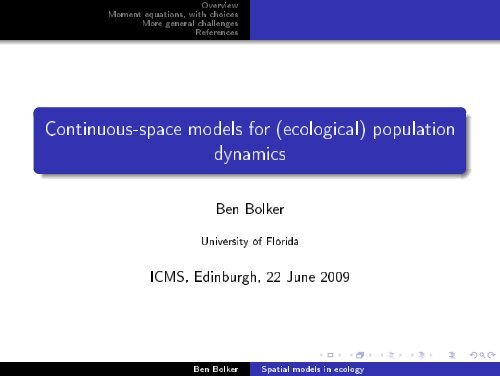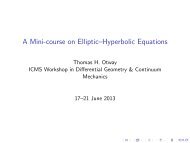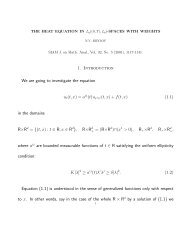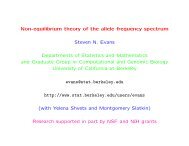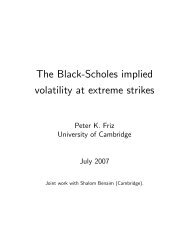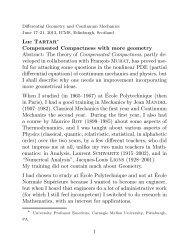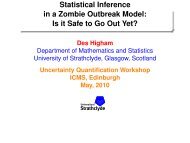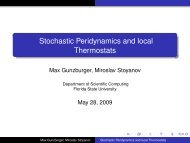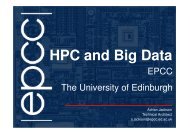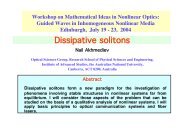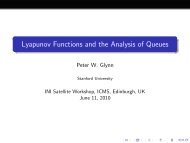Continuous-space models for (ecological) population dynamics - ICMS
Continuous-space models for (ecological) population dynamics - ICMS
Continuous-space models for (ecological) population dynamics - ICMS
You also want an ePaper? Increase the reach of your titles
YUMPU automatically turns print PDFs into web optimized ePapers that Google loves.
Overview<br />
Moment equations, with choices<br />
More general challenges<br />
References<br />
<strong>Continuous</strong>-<strong>space</strong> <strong>models</strong> <strong>for</strong> (<strong>ecological</strong>) <strong>population</strong><br />
<strong>dynamics</strong><br />
Ben Bolker<br />
University of Florida<br />
<strong>ICMS</strong>, Edinburgh, 22 June 2009<br />
Ben Bolker<br />
Spatial <strong>models</strong> in ecology
Outline<br />
Overview<br />
Moment equations, with choices<br />
More general challenges<br />
References<br />
1 Overview<br />
2 Moment equations, with choices<br />
3 More general challenges<br />
Ben Bolker<br />
Spatial <strong>models</strong> in ecology
Model classes<br />
Overview<br />
Moment equations, with choices<br />
More general challenges<br />
References<br />
Space Time Populations Stoch Model<br />
discrete discrete discrete no cellular automaton<br />
discrete discrete discrete yes probabilistic (stochastic) CA<br />
discrete discrete continuous maybe coupled-map lattice<br />
discrete continuous discrete yes interacting particle system ≈ pair approximation<br />
continuous discrete continuous maybe integrodierence eq'ns<br />
continuous either discrete yes spatial point process ≈ spatial moment<br />
equations<br />
continuous continuous continuous no integrodierential, partial dierential<br />
(reaction-diusion) eq'ns<br />
continuous continuous continuous yes stochastic integro/ partial di. eq'n<br />
Ben Bolker<br />
Spatial <strong>models</strong> in ecology
Overview<br />
Moment equations, with choices<br />
More general challenges<br />
References<br />
Model preferences: realism<br />
contiguous (lattice/network) vs. continuous <strong>space</strong>: networks<br />
may or not be spatial<br />
What is special about <strong>space</strong> (Bolker et al., 2003)<br />
PDEs, invasion waves (Fisher etc.)<br />
lattice <strong>models</strong> (IPS, CA/pair approximation): Durrett and<br />
Levin (1994)<br />
realism: points or a square (or hexagonal) lattice<br />
Connections to data . . .<br />
Ben Bolker<br />
Spatial <strong>models</strong> in ecology
Outline<br />
Overview<br />
Moment equations, with choices<br />
More general challenges<br />
References<br />
1 Overview<br />
2 Moment equations, with choices<br />
3 More general challenges<br />
Ben Bolker<br />
Spatial <strong>models</strong> in ecology
Overview<br />
Moment equations, with choices<br />
More general challenges<br />
References<br />
1 Dene the system (write master equation)<br />
2 Write expectations of change in mean and pair densities<br />
3 Assume spatial homogeneity<br />
4 Expand products as covariances<br />
5 Close moments<br />
6 Take continuum limits<br />
7 Analyze Solve numerically<br />
Ben Bolker<br />
Spatial <strong>models</strong> in ecology
Master equation<br />
Overview<br />
Moment equations, with choices<br />
More general challenges<br />
References<br />
Dene rates of a continuous-time stochastic process: patch size ω<br />
(small), positions x, y, time ∆t (small): e.g. the spatial logistic<br />
(with environmental heterogeneity in mortality rate):<br />
Event δN(x) Rate<br />
∑<br />
birth +1<br />
y∈Ω<br />
fN(y)D(y, x)ω<br />
death (dens-independent) -1 µ(x)N(x)<br />
death (crowding) -1 N(x) ∑ y∈Ω<br />
αN(y)U(y, x)<br />
All kernels are symmetric (relax) and normalized:<br />
∑<br />
y∈Ω K(y)ω = 1 Ben Bolker Spatial <strong>models</strong> in ecology
Alternatives<br />
Overview<br />
Moment equations, with choices<br />
More general challenges<br />
References<br />
more rigorous derivations: start from point-process description,<br />
or rigorous patch description (Nevai, Barton et al. (2002),<br />
Ovaskainen and Cornell (2006), most of yesterday)<br />
movement (jump processes)<br />
disturbance (spatially correlated mortality)<br />
traits (marked point processes)<br />
Diculties<br />
multi-way interactions (e.g. twinning, indirect interactions)<br />
velocity jump processes<br />
density-dependent dispersal distance<br />
Ben Bolker<br />
Spatial <strong>models</strong> in ecology
Overview<br />
Moment equations, with choices<br />
More general challenges<br />
References<br />
Calculate expectations<br />
Take expectations (1) over possible future outcomes, given starting<br />
conditions:<br />
∆N = ∑ rate i · δ i<br />
and (2) over all congurations with current summary statistics<br />
. . .<br />
〈<br />
∆N<br />
〉<br />
=<br />
〈∑<br />
ratei · δ i<br />
〉<br />
Challenges<br />
<strong>space</strong>-<strong>for</strong>-conguration substitution ergodicity/homogeneity<br />
non-homogeneous starting conditions<br />
Ben Bolker<br />
Spatial <strong>models</strong> in ecology
Overview<br />
Moment equations, with choices<br />
More general challenges<br />
References<br />
Expected change in density<br />
We get<br />
〈<br />
〉<br />
dN(x)<br />
〈∑ 〉<br />
= (ratei · δ i )<br />
dt<br />
= f ∑ y<br />
D(x, y)〈N(y)〉<br />
− (¯µ + α〈N(x)〉)〈N(x)〉<br />
− ∑ αU(x, y)〈(N(x) − 〈N(x)〉)(N(y) − ¯N(y))〉<br />
y<br />
− 〈(µ(x) − ¯µ)N(x)〉<br />
Ben Bolker<br />
Spatial <strong>models</strong> in ecology
Overview<br />
Moment equations, with choices<br />
More general challenges<br />
References<br />
Expectations of pair changes<br />
〈<br />
〉<br />
dN(x)N(y)<br />
= ∑ f<br />
dt<br />
y<br />
D(y, x)〈N(y)N(z)〉<br />
− 〈µ(x)N(x)N(y)〉<br />
− α ∑ y<br />
〈N(x)N(y)N(z)〉<br />
plus symmetric terms<br />
Ben Bolker<br />
Spatial <strong>models</strong> in ecology
Overview<br />
Moment equations, with choices<br />
More general challenges<br />
References<br />
Assume spatial homogeneity<br />
Assume second-order spatial homogeneity and isotropy: i.e.,<br />
that any 〈f (x, y)〉 depends only on |x − y|<br />
Alternatives<br />
Gradients<br />
Distance from edge of wave (pair-edge approximation:<br />
Habitat boundaries (Finite spatial patches)<br />
Ben Bolker<br />
Spatial <strong>models</strong> in ecology
Expand covariances<br />
Overview<br />
Moment equations, with choices<br />
More general challenges<br />
References<br />
Convert expectations of products (second central moments) to<br />
covariances (noncentral moments):<br />
〈<br />
(N(x) − ¯N)(N(y) − ¯N)<br />
〉<br />
≡ CNN (|x − y|)<br />
Also have C µN , C µµ (assumed static); also higher central moments<br />
M 3 N,N,N (etc.)<br />
Alternatives:<br />
work with central moments instead<br />
scaled covariances (C/N), correlations (C/N 2 )<br />
multiplicative correlations (Keeling)<br />
Ben Bolker<br />
Spatial <strong>models</strong> in ecology
Moment closure<br />
Overview<br />
Moment equations, with choices<br />
More general challenges<br />
References<br />
Power-1, -2, -3: e.g.<br />
P(x, y, z) = P(x)P(yz)+P(y)P(xz)+P(x)P(yz)−2P(x)P(y)P(z)<br />
Symmetric and asymmetric alternatives<br />
Ben Bolker<br />
Spatial <strong>models</strong> in ecology
Overview<br />
Moment equations, with choices<br />
More general challenges<br />
References<br />
Criteria <strong>for</strong> moment closure<br />
Analytical tractability (!)<br />
Invariance under relabeling (Murrell et al., 2004)<br />
Asymptotic convergence to mean-eld<br />
Non-negativity (Murrell et al., 2004)<br />
Sensible quasi-equilibrium (lim N→0 C/N) behavior<br />
Ben Bolker<br />
Spatial <strong>models</strong> in ecology
Overview<br />
Moment equations, with choices<br />
More general challenges<br />
References<br />
Invasion phases (digression)<br />
Early invasion: both local and global density ≪ 1<br />
Quasi-equilibrium: local structure established (invasion<br />
eigenvalue) [stable manifold]<br />
Spread: local structure at equilibrium, global structure out of<br />
equilibrium<br />
. . .<br />
Equilibrium local and global structure<br />
Mean should increase exponentially (non-spatial or spatial rate),<br />
then quadratically . . . may be hard to separate time scales<br />
(Mollison)<br />
Edge approximations<br />
Ben Bolker<br />
Spatial <strong>models</strong> in ecology
Continuum limits<br />
Overview<br />
Moment equations, with choices<br />
More general challenges<br />
References<br />
n = lim<br />
ω→0<br />
N/ω<br />
c = lim<br />
ω→0<br />
C/(ω 2 )<br />
End up with important singular terms (Dirac δ): because<br />
individuals are discrete, N(x) 2 scales with ω rather than ω 2<br />
Could easily dene other variance scaling (negative binomial),<br />
in an ad hoc way . . .<br />
Environmental variables (µ) scale as continuum rather than<br />
discrete variables (intensive vs. extensive)<br />
Moment equations on nite patches<br />
Ben Bolker<br />
Spatial <strong>models</strong> in ecology
Analysis/solution<br />
Overview<br />
Moment equations, with choices<br />
More general challenges<br />
References<br />
Kernel choices: Laplacian, modied Bessel, top hat (Birch<br />
and Young, 2006; Ovaskainen and Cornell, 2006)): compact<br />
support works<br />
Dimensionality<br />
Parameter choices: length scale (competition vs dispersal vs<br />
environment), eective neighborhood size<br />
Fourier or Hankel trans<strong>for</strong>m often simplies analysis (but again<br />
depends on closure)<br />
Ben Bolker<br />
Spatial <strong>models</strong> in ecology
Overview<br />
Moment equations, with choices<br />
More general challenges<br />
References<br />
electric monk: automatic moment equations<br />
High-throughput math biology<br />
The Electric Monk was a labour-saving device, like a<br />
dishwasher or a video recorder. Dishwashers washed<br />
tedious dishes <strong>for</strong> you, thus saving you the bother of<br />
washing them yourself, video recorders watched tedious<br />
television <strong>for</strong> you, thus saving you the bother of looking<br />
at it yourself; Electric Monks believed things <strong>for</strong> you, thus<br />
saving you what was becoming an increasingly onerous<br />
task, that of believing all the things the world expected<br />
you to believe . . .<br />
Douglas Adams, Dirk Gently's Holistic Detective Agency<br />
Ben Bolker<br />
Spatial <strong>models</strong> in ecology
Overview<br />
Moment equations, with choices<br />
More general challenges<br />
References<br />
electric monk: automatic moment equations<br />
High-throughput math biology<br />
The Electric Monk was a labour-saving device, like a<br />
dishwasher or a video recorder. Dishwashers washed<br />
tedious dishes <strong>for</strong> you, thus saving you the bother of<br />
washing them yourself, video recorders watched tedious<br />
television <strong>for</strong> you, thus saving you the bother of looking<br />
at it yourself; Electric Monks believed things <strong>for</strong> you, thus<br />
saving you what was becoming an increasingly onerous<br />
task, that of believing all the things the world expected<br />
you to believe . . .<br />
Douglas Adams, Dirk Gently's Holistic Detective Agency<br />
Ben Bolker<br />
Spatial <strong>models</strong> in ecology
Overview<br />
Moment equations, with choices<br />
More general challenges<br />
References<br />
eqs = {<br />
{{n1[x]},{+1}, int[f1*Dk1[y-x]*n1[y],y]},<br />
{{n1[x]},{-1}, mu[x]*n1[x]},<br />
{{n1[x]},{-1}, a11*int[Uk[y-x]*n1[y],y]*n1[x]},<br />
{{mu[x]}, {0}, 0} (* mu static *)<br />
};<br />
ContVarList={mu};<br />
ceqs0 = resort[coveqs[DDMeqs1],3] //. intrules;<br />
ceqs1 = closeM[noselfcomp[ceqs0,{Uk}],<br />
order->3,closure->power1,<br />
singm->True] //. intrules;<br />
Expand[Simplify[implicitvar[ceqs1]]]<br />
Ben Bolker<br />
Spatial <strong>models</strong> in ecology
Power-1 closure<br />
Overview<br />
Moment equations, with choices<br />
More general challenges<br />
References<br />
∂c µn<br />
∂t<br />
1 ∂c nn<br />
2 ∂t<br />
= f D ∗ c µn − µc µn − αnU ∗ c µn − αnc µn<br />
− nc µµ<br />
= f D ∗ c nn − µc nn − αnU ∗ c nn − αnc nn<br />
− nc µn + f Dn − αUn 2<br />
Ben Bolker<br />
Spatial <strong>models</strong> in ecology
Analysis<br />
Overview<br />
Moment equations, with choices<br />
More general challenges<br />
References<br />
Power-1 closure gives linear covariance equations<br />
If n is close to mean-eld eq., can compute equilibrium<br />
covariances<br />
Fourier trans<strong>for</strong>m of Laplacian e −λ|x| λ<br />
is 2<br />
λ 2 +q 2 : ditto <strong>for</strong><br />
Hankel trans<strong>for</strong>m of K 0 . Simple algebra <strong>for</strong> rational functions<br />
of kernels (partial fractions)<br />
numerical solutions (may be faster in radially<br />
symmetric/Fourier <strong>space</strong>)<br />
Ben Bolker<br />
Spatial <strong>models</strong> in ecology
Overview<br />
Moment equations, with choices<br />
More general challenges<br />
References<br />
integro-PDE analogue<br />
∂n(x, t)<br />
= f (D ∗ n) − µ(x)n(x) − αn(x) 2<br />
∂t<br />
Try to simplify the equations by assuming (1) short-range kernels<br />
(changes kernels to diusion operators), (2) local interactions: do<br />
we get to the naive reaction-diusion equation (Nevai)<br />
Ben Bolker<br />
Spatial <strong>models</strong> in ecology
Exploiting linearity<br />
Overview<br />
Moment equations, with choices<br />
More general challenges<br />
References<br />
With v = (˜c µn˜c nn ) T and φ = f ˜D − µ − αn(Ũ + 1),<br />
or<br />
( )<br />
∂v φ 0<br />
∂t = −n φ<br />
(<br />
v +<br />
˜c ∗ µn/n = c µµ /φ<br />
˜c ∗ nn/n 2 = (f ˜D − αŨn)<br />
nφ<br />
. . . dening a spatial transfer function.<br />
Deconvolution<br />
−nc µµ<br />
(f ˜D − αŨn)n<br />
+ c µµ<br />
φ 2<br />
)<br />
Ben Bolker<br />
Spatial <strong>models</strong> in ecology
Outline<br />
Overview<br />
Moment equations, with choices<br />
More general challenges<br />
References<br />
1 Overview<br />
2 Moment equations, with choices<br />
3 More general challenges<br />
Ben Bolker<br />
Spatial <strong>models</strong> in ecology
Overview<br />
Moment equations, with choices<br />
More general challenges<br />
References<br />
What do ecologists want<br />
not:<br />
general answers<br />
quantitative solutions (maybe)<br />
answers to open <strong>ecological</strong> questions<br />
simple analytical frameworks<br />
incorporation of environmental heterogeneity<br />
rigorous proofs<br />
dependence on details<br />
complex algebra<br />
self-organization, changes in stability, complex <strong>dynamics</strong> <strong>for</strong><br />
their own sake<br />
Ben Bolker<br />
Spatial <strong>models</strong> in ecology
Overview<br />
Moment equations, with choices<br />
More general challenges<br />
References<br />
Invasive species/epidemics/biocontrol<br />
Species invasion<br />
Can species x invade environment y<br />
(i.e. grow when [globally] rare)<br />
How fast does the range of species x expand Does range<br />
expansion decelerate, accelerate, or stabilize over time<br />
What matters<br />
life history (birth/death rates)<br />
competition<br />
environmental variability (<strong>space</strong> & time)<br />
demographic stochasticity ()<br />
evolution<br />
Ben Bolker<br />
Spatial <strong>models</strong> in ecology
Species coexistence<br />
Overview<br />
Moment equations, with choices<br />
More general challenges<br />
References<br />
What maintains intra-guild diversity<br />
Tradeos in <strong>space</strong> use (competition-colonization tradeos)<br />
Other correlated tradeos in growth rate, fecundity,<br />
competitive ability, dispersal in <strong>space</strong> & time (Snyder 2006)<br />
Is diversity enhanced by spatiotemporal heterogeneity How<br />
Under what conditions can organisms maintain/benet from<br />
niche separation<br />
Janzen-Connell (positive frequency-dependent) <strong>models</strong><br />
Structured many-species <strong>models</strong><br />
Ben Bolker<br />
Spatial <strong>models</strong> in ecology
Neutral theories<br />
Overview<br />
Moment equations, with choices<br />
More general challenges<br />
References<br />
Is the spatial/temporal pattern of species within guilds<br />
consistent with a neutral (symmetric, exchangeable) model<br />
(urn <strong>models</strong>)<br />
What are the expected spatial/temporal/ rank-abundance<br />
distributions, and variations around those expectations, under<br />
various <strong>models</strong> (Chave and Leigh, 2002) Can we quantify/<br />
estimate parameters <strong>for</strong> divergence<br />
Ben Bolker<br />
Spatial <strong>models</strong> in ecology
Overview<br />
Moment equations, with choices<br />
More general challenges<br />
References<br />
Community <strong>dynamics</strong><br />
What is the expected spatial distribution of natural enemies<br />
and victims<br />
How do enemies aect spatial patterning of victims<br />
Feedbacks between spatiotemporal enemy-victim <strong>dynamics</strong> and<br />
overall densities . . . eects on species coexistence (Adler and<br />
Muller-Landau, 2005) On <strong>population</strong> <strong>dynamics</strong> (cycles etc.)<br />
Food webs and food web modules (apparent competition, etc.)<br />
in <strong>space</strong><br />
Mutualism, parasitism, coevolution<br />
Ben Bolker<br />
Spatial <strong>models</strong> in ecology
Trait <strong>dynamics</strong><br />
Overview<br />
Moment equations, with choices<br />
More general challenges<br />
References<br />
Important in its own right, also as a dierent kind of <strong>space</strong><br />
Vertical (height) structure: Picard and Franc (2001) (not<br />
really!)<br />
Size structure (Delius)<br />
Quantitative genetic <strong>models</strong><br />
Ben Bolker<br />
Spatial <strong>models</strong> in ecology
More . . .<br />
Overview<br />
Moment equations, with choices<br />
More general challenges<br />
References<br />
Advection terms/velocity-jump <strong>models</strong><br />
Behavior (density-dependent dispersal, <strong>for</strong>aging) (Marion)<br />
Zeros and local fade-out: Clark et al. (2001), Boerlijst.<br />
Probability of extinction on a nite patch (Marion)<br />
Discrete time<br />
Ben Bolker<br />
Spatial <strong>models</strong> in ecology
Overview<br />
Moment equations, with choices<br />
More general challenges<br />
References<br />
Connections with data<br />
Does knowing the expected correlation structure help us t<br />
<strong>models</strong> Do we need to derive the moments of the correlation<br />
structure itself<br />
Is deconvolution possible Easy<br />
Ben Bolker<br />
Spatial <strong>models</strong> in ecology
Overview<br />
Moment equations, with choices<br />
More general challenges<br />
References<br />
Ecological questions: invasion<br />
Can a <strong>population</strong> grow when rare (Is the invasion<br />
eigenvalue> 0 What is the value of R 0 ) (Bound mean<br />
density away from zero)<br />
How fast does a species invade a novel habitat (wave speed)<br />
(Ellner et al., 1998; Lewis, 2000; Lewis and Pacala, 2000;<br />
Neubert and Caswell, 2000)<br />
Community <strong>dynamics</strong>: if N species have stable equilibria, can<br />
the N + 1 st species invade<br />
permanence: are the <strong>dynamics</strong> bounded in the <strong>space</strong> where<br />
all species have positive density<br />
invader growth rates under nonequilibrial resident <strong>dynamics</strong><br />
Ben Bolker<br />
Spatial <strong>models</strong> in ecology
Overview<br />
Moment equations, with choices<br />
More general challenges<br />
References<br />
Ecological questions: equilibria<br />
Does a non-trivial equilibrium exist<br />
How do changes in parameters, qualitative changes to the<br />
model, aect stability<br />
Transient <strong>dynamics</strong> . . .<br />
Ben Bolker<br />
Spatial <strong>models</strong> in ecology
Overview<br />
Moment equations, with choices<br />
More general challenges<br />
References<br />
Spatial <strong>models</strong> in ecology: goals<br />
capture qualitative (quantitative) <strong>dynamics</strong> of (real)<br />
<strong>ecological</strong> communities<br />
desiderata (good, cheap, fast: pick 2 out of 3:<br />
analytical tractability<br />
computational eciency<br />
realism:<br />
stochasticity (demographic & environmental)<br />
geometry of <strong>space</strong> and time<br />
Ben Bolker<br />
Spatial <strong>models</strong> in ecology
References<br />
Overview<br />
Moment equations, with choices<br />
More general challenges<br />
References<br />
Adler, F.R. and Muller-Landau, H.C., 2005.<br />
Ecology Letters, 8(4):438447.<br />
doi:10.1111/j.1461-0248.2005.00741.x.<br />
Barton, N.H., Depaulis, F., and Etheridge, A.M.,<br />
2002. Theoretical Population Biology,<br />
61(1):3148. ISSN 0040-5809.<br />
doi:10.1006/tpbi.2001.1557.<br />
Birch, D.A. and Young, W.R., 2006. Theoretical<br />
Population Biology, 70:2642.<br />
Bolker, B.M., Pacala, S.W., and Neuhauser, C.,<br />
2003. American Naturalist, 162(2):135148.<br />
Chave, J. and Leigh, E.G., 2002. Theoretical<br />
Population Biology, 62(2):153168. ISSN<br />
0040-5809. doi:10.1006/tpbi.2002.1597.<br />
Clark, J.S., Lewis, M., and Horvath, L., 2001. The<br />
American Naturalist, 157(5):537554.<br />
Durrett, R. and Levin, S., 1994. Theoretical<br />
Population Biology, 46(3):363394.<br />
Ellner, S.P., Sasaki, A., et al., 1998. Journal of<br />
Mathematical Biology, 36(5):469484.<br />
Lewis, M.A., 2000. Journal of Mathematical<br />
Biology, 41(5):430454.<br />
Lewis, M.A. and Pacala, S., 2000. Journal of<br />
Mathematical Biology, 41(5):387429.<br />
Murrell, D.J., Dieckmann, U., and Law, R., 2004.<br />
Journal of Theoretical Biology,<br />
229(3):421432. ISSN 0022-5193.<br />
doi:10.1016/j.jtbi.2004.04.013.<br />
Neubert, M.G. and Caswell, H., 2000. Ecology, 81<br />
(6):16131628.<br />
Ovaskainen, O. and Cornell, S., 2006. Proceedings<br />
of the National Academy of Sciences of the<br />
USA, 103(34):1278112786. ISSN 0027-8424.<br />
Picard, N. and Franc, A., 2001. Ecological<br />
Modelling, 145(1):6984. ISSN 0304-3800.<br />
doi:{10.1016/S0304-3800(01)00380-5}.<br />
Ben Bolker<br />
Spatial <strong>models</strong> in ecology


